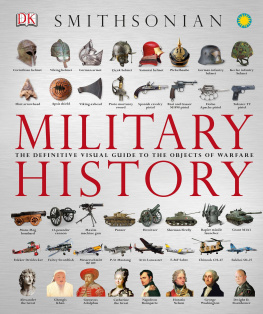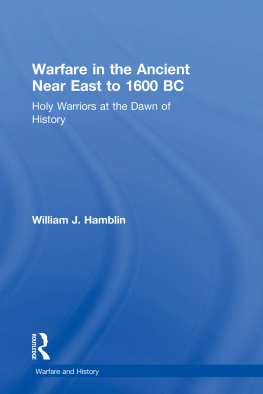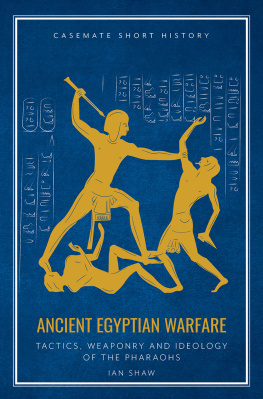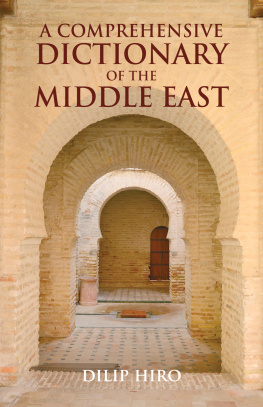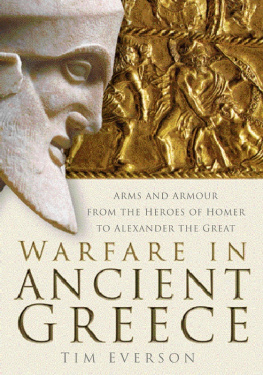TheHUTCHINSON
DICTIONARY OF
Ancient &
Medieval
Warfare
TheHUTCHINSON
DICTIONARY OF
Ancient &
Medieval
Warfare
First published in the USA and UK 1998 by
FITZROY DEARBORN PUBLISHERS
This edition published 2016 by Routledge
2 Park Square, Milton Park, Abingdon, Oxon OX14 4RN
711 Third Avenue, New York, NY 10017, USA
Routledge is an imprint of the Taylor & Francis Group, an informa business
Copyright 1998 by Helicon Publishing Ltd
All rights reserved.
No part of this book may be reproduced or transmitted in any form or by any means, electronic or mechanical, including photocopying, recording, or by any information storage and retrieval system, without permission in writing from the Publisher.
Cataloging-in-Publication Data is available from the Library of Congress and the British Library
ISBN 13: 978-1-57958-116-9 (hbk)
Contents
Warfare is as old as humankind, and a universal experience. Its evidence is all around us, from Neolithic wall-paintings of spear and bow skirmishes to the Kalashnikovs and landmines of today. Yet when we examine the warfare of the past, we confront also its ephemeral nature: we struggle to interpret the evidence before us, because the military world that gave it such urgent meaning has now all but vanished. How do the stylized 3,000-year old friezes depicting the victories of the Egyptians relate to real military experience? Who were the Greek hoplites, and what does the term othismos (shoving) tell us about their type of fighting? What was Greek Fire, or a gonfanon, or a chevauche? What happened at Dura Europus, at Dyrrachium, or at Constantinople in 1453? And the military histories of China, Japan, South Asia, Persia and Central Asia all demand our attention too but consist of events even less familiar to most of us, and terminology even more obscure. It is this obscurity that the Dictionary of Ancient & Medieval Warfare is intended to dispel, in as concise and convenient a format as possible. We have brought together specialists in many different periods of military history and many different regions of the world, to ensure that the Dictionary offers unprecedented range and authority in its coverage.
Our coverage begins with the earliest recorded military events, and ends at AD 1500. We chose this end-date not because the so-called European Middle Ages conventionally end around this time, but because the first real impact of gunpowder weaponry, the emergence of new naval and siege technology, and the rise to world dominance of the countries of northwestern Europe began around 1500 and marked a shift in the balance of military power that is still with us today. The Dictionary is therefore a key to the whole military experience of pre-modern times.
Warfare is not only a matter of terminology. The Dictionary is full of battles and wars, and of heroes too: the great commanders, and also the ordinary soldiers Egyptian charioteers, Roman legionaries, Mongol horse-archers, English bowmen, Chinese rocketeers, Burgundian artillerymen, Swiss halberdiers. The most important subjects are explored in longer articles, boxed off from the main AZ sequence of entries; some of these cover the wars and campaigns that provide the context for shorter entries, while others outline the careers of the greatest commanders, or analyse key battles in depth. comprehensive cross-references, will encourage the reader to browse, too. There cannot be many experts in European history whose understanding of warfare in past times will not be broadened by an encounter within these pages with the Green Woodsmen, Princess Trung Trac, or Tahir the Ambidextrous.
Matthew Bennett
Hartley Wintney, July 1998
General Editor
Matthew Bennett
Consultants
Peter Connolly
Professor John Gillingham
Professor John Lazenby
Contributors
Matthew Bennett
Jim Bradbury
Peter Connolly
Dr Catherine Gilliver
Dr Adrian Goldsworthy
Duncan Head
Dr Tony Heathcote
Ian V Hogg
Greg Irvine
Professor John Lazenby
Simon MacDowell
Andrew Pegler
Julie Potter
Dr Louis Rawlings
Dr Thom Richardson
The Reverend Ian Russell Lowell
Managing Editor
Katie Emblen
Project Editors
Simon Hall, Sarah Hudson
Editors
Lisa Isenman Sullivan,
Susan Mendelsohn,
Michelle Patient, Kathy Peltan,
Edith Summerhayes
Art and Design
Terence Caven
Production
Tony Ballsdon
Database Management
Nick Andrews, Graham Bennett,
Lorraine Cotterell,
Louise Richmond
Abd al-Rahman III (891961) (byname al-Nasir, the Victorious) Umayyad caliph from 912 and ruler of al-Andalus (Spain). A successful proponent of jihad against the Christian kingdoms until his defeat at Alhandega in 939, and expert at siege warfare, he brought the power of the Cordoban caliphate to its zenith. At the time of his death Umayyad military power was unchallenged.
Abd al-Rahman recaptured the Muslim cities in Spain by techniques ranging from the use of mangonels at Beja in 929 to blockade and a permanent siege camp at Toledo in 930. During the course of his reign his personal force of slave troops grew from 3,750 to 13,750, enabling him to defeat the Christians in battle. He was victor over the Basques and Leonese near Pamplona in 920, and sacked the city in 924. In 929 he declared himself caliph with the regnal title al-Nasir. After 939 he was less active in Spain, but aggressive in North Africa, taking Ceuta in 931 and Tangier in 951.
Abinger castle motte-and-bailey castle built about 1100 in Surrey, England, excavated in 1949. The motte had a flattened summit, with postholes as evidence of a wooden palisade around it containing a 4 m/12 ft square rectangular wooden keep, probably on four corner posts like stilts. The keep was rebuilt in the 12th century. A bridge linked the bailey to the motte.
Abu Bakr (573634) first Muslim caliph 63234, the political successor to the prophet Muhammad. He imposed Muslim authority over all the Arab tribes and began the expansion of Islam beyond Arabia.
Acre, Siege of (118991) siege in 118991 of the fortified port of Acre in the Holy Land (taken by the Muslims in 1187) by King Guy de Lusignan of the Christian Kingdom of Jerusalem, reinforced by crusaders. The Ayubbid sultan Saladin was unable to break the siege lines and the arrival of the English king Richard (I) the Lionheart secured the capture of the city.
King Guy besieged Acre with a small number of troops and it seemed that Saladin would overwhelm him, but the determined attackers held on. Crusader reinforcements built up the besieging forces, and the arrival in May 1191 of the kings of France and England gave them a numerical advantage and established a naval blockade. Constant Muslim attacks failed to dislodge them, and the garrison was forced to surrender. Saladin refused to pay ransom for its members, resulting in their execution.
Acre, Siege of (1291) conflict of 1291 in which Acre, the last Christian crusading bastion in the Holy Land, was captured by the Muslims, bringing about the end of the Latin Kingdom. The Muslim leader Qalawun set out to reduce Acre after provocative attacks on Muslims in the city, but died en route; his son al-Ashraf completed the attack.


